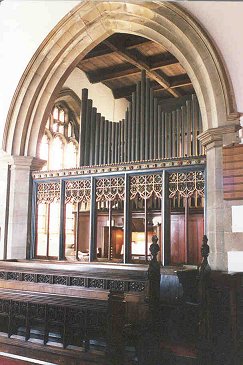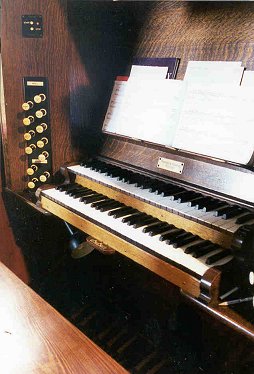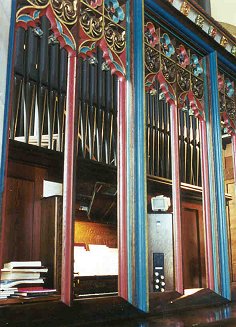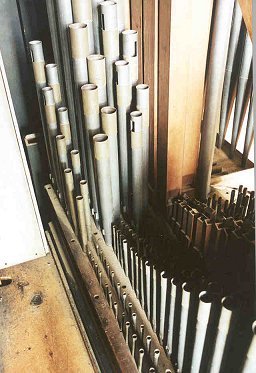 |
 |
Pipe Organs of Durham and the North East
Back to list
St Giles's Church, Gilesgate, Durham
 |
 |
St Giles's Church in its churchyard hides behind houses fronting Gilesgate Green, bisected by the old road to Sunderland. The nave structure originated as the chapel of an early 12th century hospital, outside the City walls, with the chancel added later that century. In the 19th century, a south aisle was added, doubling the church's capacity. Just a few years ago a free-standing prefabricated structure on two floors was inserted within this south aisle, providing meeting rooms and facilties.The organ sits in the south east corner of the building, with the sound boards running east-west, the pipework speaking into the chancel. Although its position (as depicted by the photographs) may look less than advantageous, it should be noted that it is not in a chamber, and there is good tonal egress - as a result the organ more than fills the church with sound and is quite capable of supporting large congregations.
This instrument was built by Harrison & Harrison in 1882, the tenth anniversary of the firm's arrival in Durham, and remains essentially unchanged since then, though the solid ivory stop knobs against a black backing board on angled jambs are an obvious 20thC alteration . More recently, the local firm of H.E.Prested overhauled the instrument, and in 1990 Harrison & Harrison undertook further restorative work.
It is interesting to note that a 13 year old Arthur Harrison was organist at this church following the organ's installation.
| Great | Swell | Pedal | |||
| Open Diapason | 8' | Bourdon | 16' | Open Wood | 16' |
| Hohl Flute | 8' | Violin Diapason | 8' | Sub Bass | 16' |
| Dulciana | 8' | Lieblich Gedeckt | 8' | Great to Pedal | . |
| Principal | 4' | Salicional * | 8' | Swell to Pedal | . |
| Harmonic Flute | 4' | Voix Célestes | 8' | . | . |
| Fifteenth | 2' | Gemshorn | 4' | Compass: | . |
| Swell to Great | . | Mixture 15.19.22 | III | Manuals C-g, 56 notes | . |
| . | . | Trumpet | 8' | Pedals C-F, 30 notes | . |
| . | . | Oboe | 8' | . | . |
| . | . | . | * C-B from Gedeckt | . | |
|
|
|||||
|
|
|||||
 |
This is a delightful sounding instrument, scarcely visible from most parts of the church - perhaps as well given its less than distinguished pipe rack front. However, tonally the sound is bright and forthright. The tracker action is adequate, although that on the Great is rather loose, whilst the Swell's possesses added weight. The Great is based on the bold Open Diapason, which adds sturdy support for congregational singing, but is perhaps a little loud to be of real use as a solo rank in the repertory. Its voicing is extremely spirited. The Principal and Fifteenth are similarly bold, and the lack of a Mixture on the Great is barely noticed, such is the vitality of this chorus. The Dulciana, partly in the north front of the organ, becomes rather edgy in the treble, but is nonetheless a useful soft rank. The Hohl Flute, and its octave partner the Harmonic Flute, are rich toned, useful as both solo and accompanimental stops. |
The Swell, in a large box behind the Great soundboard, is beautiful, particular in its quieter moments. The Violin Diapason is typically hard toned, without tiring the ear, whilst the strings are vibrant and keen. The Gemshorn is bright, and in combination with either the Diapason or the Gedeckt proves a good match for the similar Great ensemble. The Mixture is quite small, but its sparkle is much needed in the organ. The two reeds are very good - the Trumpet is powerful, and of much use coupled to the Pedal and used as a foil to the Great chorus. The Oboe is unremarkable, but a pleasant sounding rank nonetheless. It can be added imperceptibly as part of a build up to full Swell, and adds definite bite and pungency when used with the Trumpet.
The Pedal is sadly under developed by some standards, although the normal two bass stops it does possess are most useful. The Open Wood adds gravitas, without overpowering mezzoforte ensembles, whilst the Sub Bass is more gentle, and suitable for the quietest of registrations.
The specification of this instrument is not untypical of Harrison & Harrison organs of this period, which, under the direction of Thomas H.Harrison, were making a name in the North and Scotland for well made, versatile, and successful instruments, but before the firm became nationally and ultimately internationally famous .

Great pipework in situ: (L to R) 15th, Harmonic Flute 4', Principal 4', Hohl Flute 8', Dulciana 8', Open 8'Great pipes: (L to R) Principal, Hohl Flute and Harmonic Flute